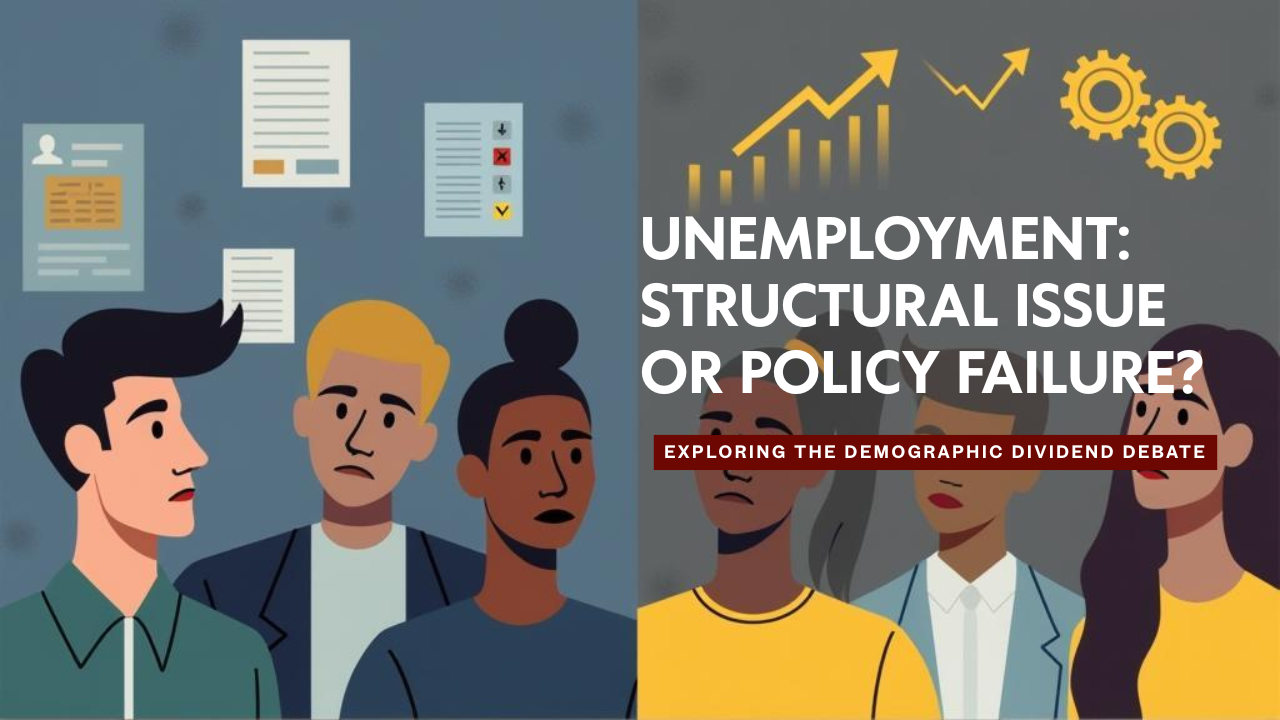
Unemployment in a Demographic Dividend Nation: Structural Issue or Policy Failure?
India is often referred to as a demographic dividend nation, a country where a significant portion of the population falls within the working-age group. This demographic advantage, if harnessed properly, can propel economic growth and elevate millions out of poverty. However, India’s persistent struggle with unemployment paints a more complicated picture. Despite a youthful population and an expanding economy, job creation remains sluggish. This paradox raises a critical question: Is unemployment in India a result of deep-rooted structural issues or a failure of policies?
---
## Understanding the Demographic Dividend
A demographic dividend refers to the economic growth potential that arises from shifts in a country’s population age structure—primarily when the working-age population (15–64 years) grows larger than the non-working-age share.
In theory, a young and energetic workforce should lead to greater productivity, innovation, and consumption. But this only materializes if there are enough productive jobs to absorb the growing labor force.
---
India’s Employment Landscape: The Reality Check
Despite the large working-age population, India faces a job crisis. According to various government and private reports:
Youth unemployment (ages 15–29) remains stubbornly high, often exceeding 20%.
Many employed individuals are engaged in low-quality informal work, lacking social security or stable incomes.
The labour force participation rate (LFPR), especially among women, is declining.
Job creation is not keeping pace with the number of new entrants into the labor market.
## Structural Issues: The Deep Roots of Unemployment
Several structural challenges hinder job creation in India:
### 1. Education-Employment Mismatch
India has made strides in improving school enrollment, but learning outcomes remain poor. Many graduates are not job-ready, leading to a growing skills gap between employer expectations and workforce capabilities.
### 2. Informal Sector Dominance
Over 85% of employment in India is in the informal sector, where jobs are typically low-paying and insecure. The formal sector has not grown fast enough to accommodate the rising working-age population.
### 3. Agricultural Dependence
A large chunk of the workforce remains trapped in low-productivity agriculture, which contributes only a small share to GDP. Diversification into industry and services has been slow and uneven.
### 4. Urban-Rural Divide
Urban areas attract more investment and jobs, but rural regions lag behind, creating a geographical imbalance in employment opportunities.
---
## Policy Failures: Missing the Mark
While structural issues are deeply entrenched, policy failures have exacerbated the problem:
### 1. Lack of Coordinated Job Strategy
India lacks a coherent national employment policy. Schemes often function in silos and fail to address the systemic nature of joblessness.
### 2. Underwhelming Industrial Policy
Manufacturing, a potential mass employer, has underperformed. Despite initiatives like Make in India, India’s manufacturing-to-GDP ratio has stagnated, unlike East Asian economies that used manufacturing as a job engine.
### 3. Skilling Initiatives with Limited Impact
Programs like Skill India have struggled with quality control, low placement rates, and weak industry linkages, rendering many skilling efforts ineffective.
### 4. Labor Laws and Ease of Doing Business
While reforms have been introduced, India still struggles with complex labor regulations that deter formal hiring. Small and medium enterprises, which could generate jobs, often find compliance too burdensome.
---
##The COVID-19 Aftershock
The pandemic dealt a severe blow to India’s labor market. Millions lost jobs, especially in the informal sector. Recovery has been uneven, and many workers have either exited the labor force or returned to precarious employment. The pandemic highlighted the fragility of India’s employment ecosystem.
---
## What Needs to Be Done?
Addressing unemployment in India requires a multi-pronged approach, tackling both structural bottlenecks and policy paralysis:
### 1. Invest in Human Capital
lImprove quality of education and vocational training.
lBridge the skill gap with industry-focused curricula.
### 2. Boost Labor-Intensive Sectors
lPromote sectors like textiles, tourism, construction, and food processing that can absorb large numbers of workers.
### 3. Formalize the Informal Sector
lProvide social security nets, financial access, and simplified compliance systems for informal enterprises.
### 4. Revamp Employment Policies
lCreate a unified employment mission with measurable targets.
lEncourage public-private partnerships for job creation.
### 5. Strengthen MSMEs
lImprove access to credit, digital tools, and market linkages for micro, small, and medium enterprises (MSMEs), the real job creators.
India stands at a critical juncture. Its demographic dividend could either be a blessing or a burden, depending on how effectively it is managed. While structural problems like skills mismatch, informal employment, and rural-urban disparities are undeniable, policy inertia and fragmented efforts have also played a role in exacerbating unemployment.
To unlock the true potential of its youth, India must invest in long-term reforms and targeted job policies. Only then can the demographic dividend be transformed from a statistical asset into a sustainable force for inclusive growth abiding too SDG-8 too.
By Ishani Aprajita





